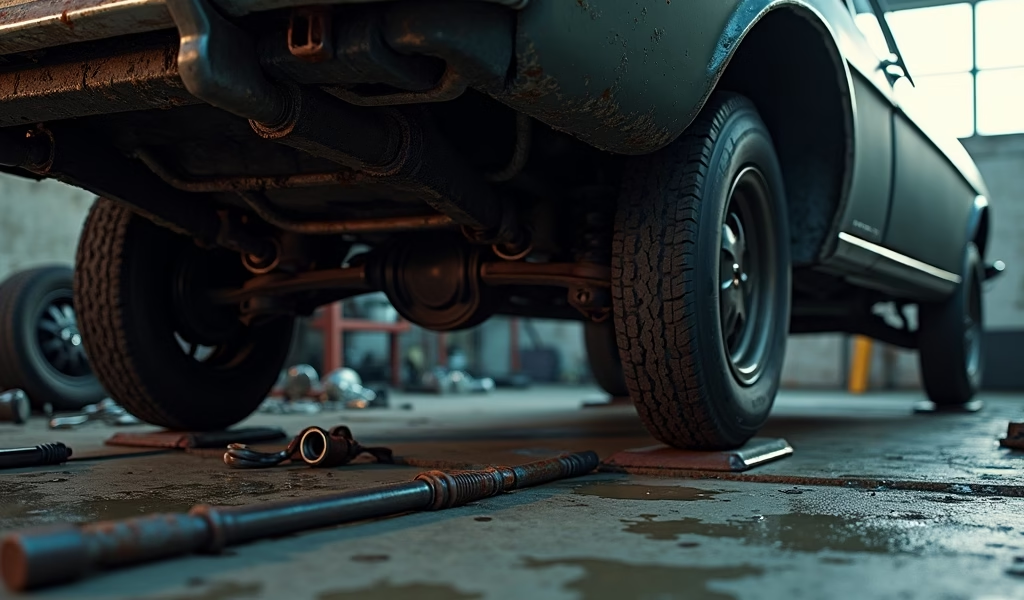Overview
The article outlines seven essential car maintenance practices for extending vehicle lifespan, including regular fluid changes, tire care, brake system upkeep, battery maintenance, air filtration replacement, suspension care, and following manufacturer service schedules. Proper maintenance not only prevents breakdowns but preserves vehicle value, enhances safety, and can help vehicles reach 200,000+ miles compared to poorly maintained ones that often fail before 100,000 miles.
Table of Contents
- Introduction to Car Platform Maintenance
- Tip #1: Regular Fluid Checks and Changes
- Tip #2: Tire Care and Rotation
- Tip #3: Brake System Maintenance
- Tip #4: Battery and Electrical System Care
- Tip #5: Air Filtration Systems
- Tip #6: Preventative Suspension Maintenance
- Tip #7: Follow Manufacturer Service Schedules
- Conclusion
- Frequently Asked Questions
Introduction to Car Platform Maintenance
Have you ever wondered why some vehicles still run like new at 200,000 miles while others struggle to reach half that? The difference often boils down to one thing: how well their owners maintained the car platform.
Let me share a little secret from my 25 years in the garage: vehicles don’t just randomly fail. They send signals—sometimes whispers, sometimes shouts—before problems escalate. The trick is learning to listen and respond.
Your car’s platform is essentially its foundation—the structural framework that supports everything from the engine to the body panels. Proper platform maintenance doesn’t just prevent breakdowns; it preserves your vehicle’s value, enhances safety, and can save you thousands in unnecessary repairs.
According to a study by Consumer Reports, vehicles with proper maintenance routines typically last 200,000+ miles, while neglected ones often fail before 100,000. That’s potentially doubling your car’s lifespan through consistent care!
Today, I’m sharing seven proven tips that have helped countless vehicles in my shop reach impressive mileages. These aren’t just theoretical recommendations—they’re practical, tested approaches that work in the real world. So let’s dive in, shall we?
Tip #1: Regular Fluid Checks and Changes
Think of your vehicle’s fluids as its lifeblood. Just as we need water to function, your car depends on various fluids to operate smoothly and avoid premature wear.
Engine oil stands at the top of the fluid hierarchy. It lubricates dozens of moving parts, prevents metal-on-metal contact, and helps cool your engine. Despite what some quick-lube places advertise, most modern vehicles don’t need oil changes every 3,000 miles. Depending on your model and driving habits, intervals between 5,000-10,000 miles are typically appropriate.
Here’s a tip from the trenches: don’t just change your oil—check it regularly between changes. A significant drop in level could indicate consumption issues or leaks that, if caught early, might save you from catastrophic engine failure.
Transmission fluid often plays second fiddle to engine oil, but neglect it at your peril. Unlike oil, transmission fluid doesn’t burn off, but it does degrade and collect debris over time. Most manufacturers recommend changes every 30,000-60,000 miles. When a customer comes in with shifting problems, my first question is always: “When was your last transmission fluid service?”
Don’t forget these other critical fluids:
- Brake fluid: Absorbs moisture over time, reducing effectiveness (replace every 2-3 years)
- Coolant: Prevents freezing, overheating, and corrosion (flush every 30,000-50,000 miles)
- Power steering fluid: Enables smooth steering operation (check regularly, replace if dirty)
According to a Car Care Council study, nearly 22% of vehicles have low or dirty engine oil, and about 20% have inadequate cooling protection. These easily preventable conditions lead to thousands of premature breakdowns annually.
Tip #2: Tire Care and Rotation

Your tires are the only parts of your vehicle that actually touch the road, making them critical to safety, handling, and efficiency. Yet too many drivers take a “replace them when they’re bald” approach, missing out on years of potential service life.
Let’s start with the simplest aspect of tire maintenance: proper inflation. I’ve seen countless premature tire replacements that could have been avoided with a $2 pressure gauge and five minutes a month. Underinflated tires flex more, build up heat, and wear faster. They also reduce fuel economy by up to 3%, according to the U.S. Department of Energy.
What’s the correct pressure? Not what’s printed on the tire sidewall—that’s the maximum rating. Check your vehicle’s doorjamb sticker or owner’s manual for the proper specification.
Tire rotation is another simple practice with big returns. By regularly rotating tires (typically every 5,000-7,500 miles), you distribute wear evenly across all four tires. Think about it—your front tires handle most braking and turning forces, while rear tires follow a different wear pattern. Rotation equalizes these differences.
Watch for these tire wear patterns—they’re like your car talking to you:
- Wear on both outer edges: Underinflation
- Wear in the center: Overinflation
- Wear on just one edge: Alignment issues
- Scalloped pattern: Suspension problems
I’ve seen proper tire maintenance extend tire life by 20,000+ miles. At today’s prices, that’s significant savings over your vehicle’s lifetime. Plus, you’ll enjoy better handling, improved safety, and increased fuel efficiency along the way.
Tip #3: Brake System Maintenance
When it comes to crucial vehicle systems, nothing tops your brakes. They quite literally stand between routine driving and potential disaster. Yet many drivers wait for alarming noises or reduced stopping power before seeking service.
Brake pads are wear items designed to sacrifice themselves to protect more expensive components. Most pads include wear indicators that produce a squealing sound when they’re nearing end-of-life. But why wait for that warning? Regular inspections can catch issues before they become safety concerns.
Typical brake pad life varies widely based on driving habits and conditions:
- City driving with frequent stops: 30,000-40,000 miles
- Highway driving: 50,000-70,000 miles
- Performance driving or mountainous terrain: As low as 15,000-25,000 miles
Here’s what I tell my customers: the cost difference between replacing just pads versus pads and rotors can be substantial. Waiting too long often means damaged rotors that could have been preserved with timely pad replacement.
Beyond pads and rotors, your brake system relies on hydraulic fluid to transfer force from your foot to the wheels. This fluid absorbs moisture over time, lowering its boiling point and potentially causing brake fade during hard stops. Most manufacturers recommend replacing brake fluid every 2-3 years regardless of mileage.
I’ve seen perfectly good vehicles prepared for car sales get lowballed because of obvious brake system neglect. Buyers (rightly) wonder what else has been overlooked if something as fundamental as brakes hasn’t been maintained.
According to the National Highway Traffic Safety Administration, brake-related problems contribute to approximately 22% of crashes where vehicle factors are cited. Regular maintenance isn’t just about saving money—it’s about protecting lives.
Tip #4: Battery and Electrical System Care
Ever notice how batteries seem to fail on the coldest morning of winter or when you’re running late for an important meeting? There’s a reason for that timing—batteries often show no symptoms until they’re pushed beyond their capacity.
The average car battery lasts 3-5 years, but this varies dramatically based on climate and driving habits. Extreme temperatures are particularly hard on batteries—heat accelerates internal corrosion, while cold reduces chemical efficiency.
One of the best preventative measures is simply keeping your battery clean. Those whitish, powdery deposits on terminals (corrosion) restrict current flow and can prevent proper charging. A simple solution of baking soda and water, along with a wire brush, can restore connections and extend battery life.
Want a pro tip? Have your battery tested before extreme seasons hit. Most auto parts stores offer this service for free, and it can predict failures before they leave you stranded. A battery can test perfectly fine in mild weather but fail at the first cold snap.
Beyond the battery itself, your vehicle’s alternator keeps everything charged while running. Warning signs of alternator issues include:
- Dimming headlights or interior lights
- Warning lights on the dashboard
- Electrical systems operating slower than normal
- Battery draining overnight
I’ve saved customers thousands by identifying alternator issues before they stranded them (and damaged their batteries in the process). A failing alternator often damages new batteries quickly, leading to a frustrating cycle of replacements.
According to AAA, battery-related issues remain one of the top reasons for roadside assistance calls, with over 7 million service calls annually. A little preventative care goes a long way in avoiding becoming part of that statistic.
Tip #5: Air Filtration Systems

Your car, much like you, needs to breathe clean air to function properly. There are actually two distinct air filtration systems in modern vehicles, and both deserve regular attention.
The engine air filter prevents dust, debris, and other contaminants from entering your engine. A clean filter ensures proper air-fuel mixture, optimal performance, and maximum fuel efficiency. When this filter becomes clogged, your engine has to work harder to draw air in—like trying to breathe through a straw.
How often should you replace it? Most manufacturers recommend every 15,000-30,000 miles, but this varies based on driving conditions. Rural gravel roads or dusty environments might require changes as frequently as 10,000 miles.
Here’s a simple test: hold your air filter up to a bright light. If you can’t see light passing through it, it’s time for a replacement. Many filters can be changed at home with basic hand tools, saving you service costs.
The cabin air filter, meanwhile, protects you rather than the engine. It filters the air entering the passenger compartment, trapping pollen, dust, and other airborne particles. If you notice reduced airflow from vents, unusual odors, or increased allergy symptoms while driving, your cabin filter is likely overdue for replacement.
I’ve had asthmatic customers experience significant relief after replacing neglected cabin filters. One customer even reported that her “new car smell” returned after a cabin filter replacement in her three-year-old vehicle!
According to testing by Consumer Reports, severely clogged air filters can reduce acceleration performance, though modern engine management systems typically compensate to maintain fuel efficiency. Either way, clean filters support optimal engine health and comfort.
Tip #6: Preventative Suspension Maintenance
Your suspension system does far more than just provide a comfortable ride. It maintains tire contact with the road, affects handling precision, influences braking distances, and plays a crucial role in overall safety.
The challenge with suspension maintenance is that degradation happens gradually. Like slowly boiling a frog (not that I recommend that!), you might not notice declining performance until it’s dramatically different from the original state.
Shocks and struts are the primary wear components in most suspension systems. Their job is to control the movement of springs, preventing excessive bouncing after bumps. Most manufacturers suggest inspection around 50,000 miles, with replacement typically needed between 50,000-100,000 miles depending on roads and driving style.
How can you tell if your shocks or struts are worn? Look for these telltale signs:
- Vehicle continues bouncing after hitting bumps
- Nose diving during braking
- Excessive body lean in corners
- Uneven tire wear patterns
- Fluid leaking from shocks/struts
Beyond shocks and struts, don’t overlook other suspension components like ball joints, tie rod ends, bushings, and control arms. These components wear over time and can cause handling issues or unusual noises when they begin to fail.
I’ve seen car trade values drop significantly when appraisers detect worn suspension components. It’s not just about comfort—buyers recognize that neglected suspension often indicates broader maintenance neglect.
A quality suspension inspection should be part of your annual maintenance routine. The peace of mind alone is worth it, and catching issues early typically saves money in the long run by preventing cascading wear to related components.
Tip #7: Follow Manufacturer Service Schedules
Have you ever wondered why your vehicle’s manufacturer created such detailed maintenance schedules? They’re not trying to generate service revenue—they’re providing a roadmap to maximize your vehicle’s lifespan and reliability.
Manufacturer schedules are developed through extensive testing and real-world data collection. They account for the specific materials, designs, and engineering compromises in your particular vehicle. Following these schedules is one of the most effective ways to prevent premature failures and maintain optimal performance.
Some critical services that should never be skipped include:
- Timing belt replacement (if equipped): Usually every 60,000-100,000 miles, catastrophic engine damage can result from failure
- Spark plug replacement: Intervals vary widely from 30,000-100,000+ miles depending on plug type
- Fuel filter changes: Typically every 30,000-60,000 miles on vehicles with replaceable filters
- Differential and transfer case fluid changes (for applicable vehicles): Often overlooked but critical for drivetrain longevity
Your owner’s manual likely has different schedules for “normal” and “severe” driving. Here’s what many people miss: most driving actually qualifies as “severe” in the manufacturer’s eyes. Short trips, stop-and-go traffic, extreme temperatures, and towing all push your vehicle into the severe service category, requiring more frequent maintenance.
Modern vehicles often have maintenance reminder systems based on driving habits and operating conditions. These systems monitor factors beyond simple mileage—they track engine revolutions, temperature cycles, and other wear indicators to determine optimal service timing.
Comprehensive service records don’t just help you track maintenance—they significantly boost resale value. A vehicle with complete records documenting adherence to manufacturer schedules can command 10-15% more in the pre-owned market compared to an identical vehicle with unknown history.
Conclusion
Proper car platform maintenance isn’t just about preventing breakdowns—it’s about preserving your investment, ensuring safety, and maximizing the value you receive from your vehicle. With the average new car price now exceeding $47,000, protecting that investment makes more financial sense than ever.
Consider this: preventative maintenance typically costs a few hundred dollars annually, while major repairs often run into thousands. That $150 transmission fluid change you’ve been postponing? It could prevent a $4,000 transmission replacement down the road.
The good news is that today’s vehicles are engineered to last longer than ever before. With proper care, reaching 200,000+ miles isn’t just possible—it’s becoming commonplace. But those impressive lifespans only materialize with consistent, appropriate maintenance.
I encourage you to create a personal maintenance calendar based on your manufacturer’s recommendations and your specific driving conditions. Many smartphone apps can help track maintenance schedules and send reminders when service is due.
Remember, your vehicle constantly communicates its needs through sounds, feelings, and performance changes. Learning to listen to these signals and responding appropriately is the essence of good car stewardship.
What maintenance practices have helped your vehicles achieve impressive lifespans? Share your experiences in the comments below—your insights might help another driver avoid costly repairs!
Frequently Asked Questions
What exactly is a car platform?
A car platform is the foundational architecture or structural framework upon which a vehicle is built. It includes the chassis, floor pan, and other basic structural elements that determine the vehicle’s dimensions, driving dynamics, and compatibility with various components.
How often should I perform basic car platform maintenance?
Basic maintenance should follow your manufacturer’s recommended schedule, typically found in your owner’s manual. For most vehicles, this includes oil changes every 5,000-10,000 miles, tire rotations every 5,000-7,500 miles, and comprehensive inspections annually.
Can I maintain my car platform myself or do I need a professional?
Many maintenance tasks like fluid checks, air filter replacements, and tire pressure monitoring can be performed by owners with basic knowledge. However, complex procedures involving suspension, braking systems, or drivetrain components typically require professional expertise and equipment.
What’s the most commonly overlooked maintenance item?
Transmission fluid service is frequently neglected because transmissions don’t provide obvious warning signs until damage has occurred. Many drivers mistakenly believe transmissions are sealed for life when they actually require periodic fluid changes.
How does maintenance affect my car’s resale value?
Well-documented maintenance history can increase resale value by 10-15% compared to identical vehicles with unknown maintenance backgrounds. Buyers are willing to pay premium prices for vehicles with proof of consistent, appropriate care.

